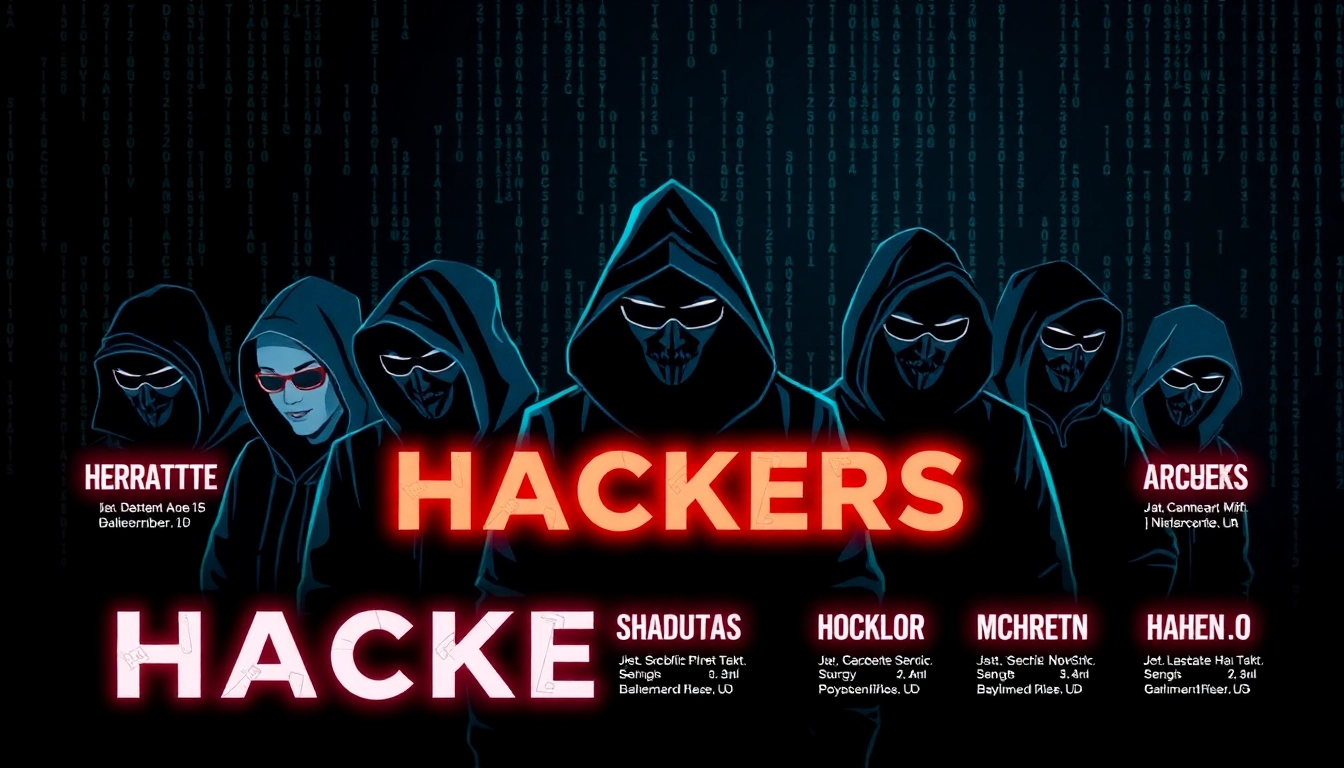10 Infamous Hackers You Should Know: A Comprehensive Hackers List
Understanding the World of Hackers
The realm of hacking is often misunderstood, shrouded in myths and polarized perspectives. On one hand, hackers are viewed as the nefarious figures behind cyber threats that jeopardize individual privacy and national security. On the other hand, there are those who leverage their skills for noble purposes, vastly improving cybersecurity frameworks. This article aims to explore the nuanced world of hackers, emphasizing the significance of distinguishing between various types of hackers and understanding their societal implications. We will delve into a hackers list that outlines not just the infamous figures, but also ethical hackers who play a critical role in today’s digital landscape.
1. What Defines a Hacker?
A hacker is generally defined as someone who uses technical skills to overcome problems or exploit weaknesses in a computer system or network. While the media often depicts hackers in a negative light, the reality is that hacking encompasses a wide range of activities that fall into various categories — ethical, malicious, and everything in between. The hacker’s motivation, regarding whether it is for profit, curiosity, or altruism, plays a crucial role in defining the impact of their actions.
2. Types of Hackers: Good vs. Bad
In the most simplistic terms, hackers can be categorized into three main types: black hat, white hat, and gray hat hackers.
- Black Hat Hackers: These are the ‘bad guys’ of the hacking world. They exploit vulnerabilities in systems for malicious purposes, including identity theft, data breaches, and financial fraud.
- White Hat Hackers: Contrary to their black hat counterparts, white hat hackers utilize their skills to protect systems and networks. Often employed by companies, they perform penetration testing and security audits to uncover vulnerabilities before they can be exploited by malicious hackers.
- Gray Hat Hackers: These hackers fall somewhere in between. They may discover vulnerabilities without permission but typically do not exploit them for malice. Instead, they may alert the organization about the issue in exchange for recognition or a reward.
3. The Impact of Hackers on Society
The impact of hacking can be multifaceted. On one side, black hat hackers can cause significant harm by accessing sensitive information, compromising infrastructure, and disrupting services. For example, the 2017 Equifax breach exposed personal data of 147 million Americans, leading to financial fraud and identity theft for many.
On the flip side, the contributions of ethical hackers are invaluable. High-profile breaches have pushed organizations to employ cybersecurity experts proactively. White hat hackers work tirelessly to identify vulnerabilities, often engaging in bounties that organizations offer to uncover flaws. This dynamic relationship enhances the overall security framework, making systems more resilient against attacks.
Spotlight on Famous Hackers
1. Kevin Mitnick: The Master of Deception
Kevin Mitnick gained notoriety as one of the most famous hackers in history. His exploits in the 1990s included breaking into the computer systems of major corporations such as IBM and Nokia, often using social engineering techniques. Mitnick’s story is not merely one of crime but also redemption; today, he is a celebrated speaker and security consultant, sharing insights gained from his past to educate others on cybersecurity.
2. Julian Assange: Whistleblower or Traitor?
Julian Assange is a polarizing figure in the hacking community. Founder of WikiLeaks, Assange believes in transparency and a free press, which led to the release of numerous classified documents. While some view him as a valiant whistleblower exposing government corruption, others see him as a traitor jeopardizing national security. This controversy underscores the ethics of hacking and information dissemination in the digital age.
3. Exploring Lesser-Known Hackers
While names like Mitnick and Assange often dominate discussions, there are many lesser-known hackers who have significantly impacted the cybersecurity landscape. For instance, Gary McKinnon famously hacked NASA and the U.S. military, claiming to have uncovered evidence of UFOs. His actions initiated lengthy legal battles and raised questions about national security protocols. Another example is Anonymous, a decentralized hacktivist collective that has targeted various organizations for their unethical practices.
The Ethics of Hacking
1. What is Ethical Hacking?
Ethical hacking refers to the practice of intentionally probing systems for vulnerabilities with permission and intent to improve security. This concept has gained traction as businesses recognize the necessity of safeguarding their digital assets against potential threats. Ethical hackers often possess standardized credentials, like Certified Ethical Hacker (CEH), showcasing their expertise and adherence to ethical guidelines.
2. Contributions to Cybersecurity
Ethical hackers are fundamental in building robust cybersecurity infrastructures. They simulate attacks to identify weaknesses and recommend appropriate solutions. For example, a company might hire ethical hackers to conduct a penetration test. The resulting insights can help the organization fortify its defenses against external and internal attacks. This proactive approach significantly reduces the chances of a successful cyber intrusion.
3. Ethical Dilemmas Faced
Despite the good intentions behind ethical hacking, practitioners often face ethical dilemmas. For instance, when discovering significant vulnerabilities, should they disclose them immediately or provide the organization time to address the issue? Similarly, ethical hackers must navigate the gray areas of exploitation; determining what constitutes responsible disclosure can be contentious.
Preventing Cybercrime
1. Best Practices for Online Security
To mitigate risks associated with hacking, individuals and organizations must adopt effective cybersecurity practices. Here are some best practices:
- Regularly update software to patch security vulnerabilities.
- Utilize strong, unique passwords for different accounts.
- Implement multi-factor authentication (MFA) wherever possible.
- Educate employees about phishing attacks and social engineering tactics.
- Conduct regular security audits and penetration tests.
2. How to Protect Yourself from Hackers
Individuals can further safeguard their information by taking specific steps:
- Be cautious about sharing personal information online, especially on social media platforms.
- Use reputable antivirus software and keep it up to date.
- Limit the use of public Wi-Fi or employ a Virtual Private Network (VPN) when necessary.
- Regularly monitor financial accounts for unauthorized transactions.
3. Role of Technology in Cyber Defense
Technology plays a crucial role in defending against cyber threats. Various tools, such as intrusion detection systems (IDS), firewalls, and encryption protocols, are essential in building resilient security frameworks. Moreover, machine learning and artificial intelligence are becoming integral in identifying threats and responding in real-time, allowing organizations to stay ahead of evolving cyberattacks.
The Future of Hacking and Cybersecurity
1. Trends in Hacker Techniques
The landscape of hacking is continually evolving. Today, hackers employ sophisticated methods, including ransomware attacks, advanced persistent threats (APTs), and social engineering. The rise of ransomware attacks has been remarkable, as hackers target organizations for financial gain, often encrypting data and demanding payment for restoration. In contrast, APTs are geared towards gaining prolonged access to networks, often for espionage or theft.
2. Preparing for the Next Wave of Cyber Threats
As technology advances, so do the techniques employed by hackers. Organizations must remain vigilant by investing in continuous education and adapting their security practices. Understanding emerging threats, such as IoT vulnerabilities and cloud security challenges, will be essential in preparing for future threats. Cyber resilience is built on the notion of anticipating potential issues and establishing an agile response mechanism.
3. How Businesses Can Stay Ahead
To stay ahead in the cybersecurity race, organizations should take a multifaceted approach, including:
- Investing in ongoing worker training programs focused on security awareness.
- Regularly reviewing and updating incident response plans and security policies.
- Collaborating with other businesses and security professionals to share insights on threats and vulnerabilities.
- Utilizing threat intelligence platforms to stay informed about current attack vectors and techniques.
In conclusion, understanding the diverse world of hackers is crucial in navigating today’s complex cybersecurity landscape. Whether it’s safeguarding personal data or protecting corporate infrastructures, distinguishing between the types of hackers and their ethical implications can shape how we respond to the ongoing challenges posed by cyber threats. By fostering a culture of awareness and proactive defense, we can mitigate the risks while empowering ethical hackers to enhance our collective security.


